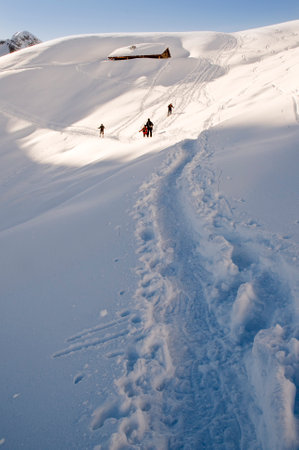1. Seasonal Causes and Regional Variations of Muddy Trails
Every hiker in the United States knows that spring and fall often bring slippery, muddy trails. But why does this happen, and what makes some regions muddier than others? Let’s break down the main causes of muddy trail conditions and explore how different areas across the country are affected.
Major Causes of Muddy Trails in Spring and Fall
- Snowmelt: In many parts of the U.S., especially in northern states and mountainous regions, snow melts rapidly as temperatures warm up in spring. This meltwater soaks into the ground, saturating trails and turning dirt to mud.
- Rainfall: Both spring showers and autumn rains can quickly overwhelm trail drainage systems. Frequent storms or heavy downpours leave paths wet and sticky for days.
- Cooler Temperatures: In fall, cooler air means water evaporates slower. Trails stay wet longer after a rainstorm compared to summer months.
Regional Differences Across the United States
Muddy trail conditions aren’t the same everywhere. The United States has a huge variety of landscapes, climates, and soil types that all affect how trails respond to moisture. Here’s a look at how different regions experience muddy conditions:
| Region | Main Cause of Muddy Trails | Common Trail Types Affected | When It Happens Most |
|---|---|---|---|
| Northeast (e.g., New England, Appalachians) | Snowmelt & Rainfall | Wooded footpaths, rocky slopes | Late March-May, October-November |
| Pacific Northwest (e.g., Washington, Oregon) | Persistent Rainfall | Dirt tracks, forest trails | October-June |
| Rocky Mountains (e.g., Colorado, Montana) | Heavy Snowmelt | Alpine trails, switchbacks | April-June |
| Southeast (e.g., Smoky Mountains) | Spring Showers & Humidity | Muddy lowlands, streamside paths | March-May, September-November |
| Southwest (e.g., Arizona, Utah) | Sporadic Rainfall (Monsoons) | Canyon paths, desert washes | July-September (monsoon), also early spring if wet winter occurred |
| Midwest (e.g., Minnesota, Wisconsin) | Soggy Ground from Thawing Snow & Rains | Lakeside trails, forest loops | March-May, October-November |
The Role of Trail Construction and Soil Type
The way a trail is built and the type of soil it runs through also impact muddiness. Trails with clay-heavy soils tend to stay slick longer because clay holds water. Well-drained gravel paths dry out faster. Some parks use boardwalks or raised walkways in known problem spots to keep hikers above the muck.
Muddy trails are a normal part of hiking during shoulder seasons—knowing what causes them helps you plan your adventure and protect your favorite wild places.
2. Recognizing and Assessing Hazardous Trail Conditions
Identifying Muddy Trails
Spring thaws and autumn rains often turn hiking paths into muddy messes. Not all mud is created equal, though! Knowing how to spot different types of mud can help you decide if a trail is safe to hike or if it’s better to turn back. Here’s a simple breakdown of common muddy conditions:
| Mud Type | Description | What To Do |
|---|---|---|
| Sticky Clay | Thick, clings to boots, makes walking tough | Consider turning back or find alternate routes |
| Slick Topsoil | Slippery surface, especially on slopes | Use trekking poles and take small steps |
| Puddle-Filled Ruts | Deep pools of water, hard to gauge depth | Walk around edges when possible |
| Loose, Wet Gravel | Gravel mixed with water, shifts underfoot | Tread carefully; avoid steep inclines |
Spotting Slippery Slopes and Unstable Surfaces
When trails are muddy, slopes become especially hazardous. Watch for:
- Bare patches on hillsides: These can turn into slick slides after rain or snowmelt.
- Roots and rocks: Hidden by mud, they can trip you up or cause slips.
- Eroded trail edges: Stay away from crumbling sides where the ground may give way.
- Mossy stones: Extra slippery when wet — step carefully or avoid them altogether.
Quick Tips for Assessing Trail Safety
- If your boots sink deeper than an inch in the mud, reconsider your route.
- If you notice fresh footprints filled with water, the trail is likely saturated and unstable.
- If you see signs warning about seasonal trail closures due to mud, always respect them — they’re there for your safety and to protect the environment.
- If you’re unsure about the stability of a section, test it gently with your foot before committing your weight.
Your Safety Comes First!
The best way to enjoy spring and fall hikes is to stay alert for changing conditions. By learning how to recognize hazardous trails before you get in too deep (literally!), you’ll keep yourself — and the trail — in good shape for future adventures.
![]()
3. Responsible Trail Use: Leave No Trace Principles
When you hit the trails during muddy spring thaws or after fall rains, it’s important to think about how your choices impact both the environment and fellow hikers. Practicing Leave No Trace principles helps protect our wild places, especially when trail conditions are less than ideal.
Minimizing Your Impact on Muddy Trails
Muddy trails are fragile. Walking directly through mud can widen trails, create deep ruts, and damage plant life along the edges. To help keep our favorite hiking spots in great shape, follow these best practices:
| Best Practice | Why It Matters |
|---|---|
| Stay on the Trail | Avoid stepping off to the side, even if it’s muddy. Stepping around mud widens the trail and damages surrounding plants. |
| Walk Through the Mud | If you can do so safely, walk straight through muddy sections to keep the trail narrow and defined. |
| Wear Proper Footwear | Waterproof boots or shoes with good grip make navigating slippery slopes safer for you and gentler on the trail. |
| Turn Back If Necessary | If the trail is too wet or your steps are causing excessive damage, consider coming back another day. |
Detour Etiquette: When to Reroute (and When Not To)
Sometimes you’ll see a detour around a very muddy spot—maybe other hikers have already created a “social trail.” While it might seem polite to avoid making a mess, detouring off-trail can actually harm vegetation and lead to erosion. Only use official reroutes marked by trail staff or signs. If there isn’t one, stay on the main path, even if it means getting a little dirty!
Boot Cleaning: Keep Trails and Nature Healthy
Mud isn’t just messy—it can carry seeds from invasive plants or harmful microbes that disrupt local ecosystems. Cleaning your boots before and after hitting the trail protects both nature and future hikers.
Simple Boot Cleaning Tips:
- Brush off mud with a stiff brush at home or at designated stations near popular trailheads.
- If possible, rinse boots with water away from streams or lakes to avoid contaminating waterways.
- Let boots dry completely before your next adventure to prevent spreading plant diseases.
By following these simple steps, you’ll help keep America’s trails beautiful and accessible for everyone—now and in the seasons to come.
4. Essential Gear and Preparation for Muddy Hikes
Choosing the Right Footwear
When you’re hitting muddy trails in spring or fall, having the right footwear is a game-changer. Waterproof hiking boots with good ankle support are key. Look for deep, grippy lugs on the sole to help prevent slips and falls. Trail runners can also work if they have aggressive tread and you’re not carrying a heavy pack.
| Footwear Type | Best For | Key Features |
|---|---|---|
| Waterproof Hiking Boots | Muddy, uneven terrain; extra ankle support needed | Waterproof membrane, high-traction sole, sturdy build |
| Trail Running Shoes | Lighter loads; faster pace on less technical trails | Aggressive tread, lightweight, quick-drying materials |
| Mud-Specific Boots | Deep mud, super slick slopes | Tall shaft, extra-deep lugs, full waterproofing |
Trekking Poles: Your Best Friend in the Mud
Trekking poles can make a big difference when navigating slippery slopes. They give you two extra points of contact with the ground, helping maintain balance and stability. Adjustable poles are best so you can change the length for steep uphill or downhill sections. In really slick conditions, use wider baskets to keep your poles from sinking too deep into the mud.
Gaiters: Keep the Grit Out
No one likes soggy socks filled with grit. Gaiters are simple covers that go over your boots and lower legs to keep mud, water, and debris out. For muddy hikes, choose waterproof gaiters that fit snugly and come up at least mid-calf.
Packing Smart: Other Must-Have Gear
- Extra Socks: Pack at least one dry pair to swap out if your feet get soaked.
- Trash Bag or Dry Sack: For storing wet or muddy gear after your hike.
- Microspikes: If there’s still lingering ice or packed snow mixed with mud in springtime.
- Quick-Dry Clothing: Avoid cotton; synthetic layers dry faster and help keep you comfortable.
- Hand Towel or Wet Wipes: For cleaning up after particularly messy stretches.
Pro Tips Before You Go
- Check Trail Reports: Many U.S. parks and trail organizations post recent trail conditions online.
- Avoid Spreading Mud: Clean your gear before heading to another area to prevent spreading invasive species.
- Plan for Slow Progress: Muddy trails take longer to navigate safely—give yourself plenty of time!
Muddy hikes can be challenging but fun with the right preparation and gear. A little planning goes a long way toward keeping your feet dry, your spirits high, and your adventure safe.
5. Trail Etiquette and Safety in Slick Conditions
Sharing Muddy Trails with Others
Muddy and slippery trails can be tough to navigate, especially during the wet months of spring and fall. When you’re out hiking, it’s important to be mindful of other trail users. Whether you’re hiking solo or in a group, here are some easy ways to keep things friendly and safe:
| Etiquette Tip | What To Do |
|---|---|
| Yielding Right of Way | Step aside for uphill hikers—they have the harder climb! If youre biking, always yield to hikers and horses. |
| Stay on the Trail | Avoid walking around muddy spots; stick to the main path to prevent trail widening and erosion. |
| Group Awareness | If you’re with a group, hike single file through muddy stretches so others can pass easily. |
| Respect Personal Space | Give folks plenty of room, especially if they need extra balance on slick slopes. |
Communicating with Fellow Hikers
Good communication goes a long way when trails are messy. A simple “hello” or “trail on your left!” helps everyone stay aware and safe. Here are some tips:
- Let others know if you plan to pass, especially in narrow or slippery spots.
- If someone looks like they’re struggling, offer a hand or ask if they need help.
- Use friendly gestures—like a wave or nod—to acknowledge others on the trail.
Staying Safe on Slippery Trails
Slick conditions require extra caution. Here’s how you can protect yourself and others:
| Safety Practice | Description |
|---|---|
| Wear Proper Footwear | Choose boots with good tread for traction in mud and wet leaves. |
| Pace Yourself | Slow down, take smaller steps, and watch your footing to avoid slips. |
| Use Trekking Poles | Pole support adds balance, especially on steep or slick sections. |
| Avoid Risky Shortcuts | Stick to marked trails—cutting corners can damage sensitive areas and increase your risk of falling. |
| Check Weather Updates | If storms or heavy rain are expected, consider rescheduling your hike for safety. |


